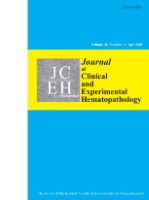
Journal of Clinical and Experimental Hematopathology
Scope & Guideline
Catalyzing Global Collaboration in Hematopathology.
Introduction
Aims and Scopes
- Hematologic Malignancies Research:
The journal emphasizes research on various hematologic malignancies, including lymphomas, leukemias, and plasma cell disorders. It covers both clinical and experimental studies that contribute to the understanding of these diseases. - Clinical Case Reports and Reviews:
A significant portion of the journal includes case reports and literature reviews that provide insights into rare and complex cases, thereby enhancing clinical knowledge and guiding treatment strategies. - Pathological Insights and Diagnostics:
The journal highlights the importance of pathology in diagnosing hematologic disorders. It publishes studies focusing on histopathological evaluations, immunohistochemistry, and molecular techniques that assist in accurate diagnosis. - Therapeutic Advances and Clinical Trials:
Research on new therapeutic approaches, including novel drug treatments and clinical trial outcomes, is a core focus. The journal aims to disseminate findings that can influence treatment protocols and improve patient outcomes. - Tumor Microenvironment and Immune Response:
There is a growing emphasis on the role of the tumor microenvironment and immune interactions in hematologic diseases. The journal explores how these factors affect disease progression and treatment responses.
Trending and Emerging
- Precision Medicine and Targeted Therapies:
There is a significant trend towards research focused on precision medicine and targeted therapies for hematologic malignancies. This includes studies on specific genetic mutations, biomarkers, and tailored treatment approaches that enhance efficacy and minimize toxicity. - Immunotherapy and CAR T-cell Therapy:
Immunotherapy, particularly CAR T-cell therapy, is gaining prominence in the journal's publications. Research exploring the mechanisms, efficacy, and safety of these therapies is increasingly relevant as they become standard treatment options for various hematologic cancers. - Tumor Microenvironment Studies:
Emerging themes related to the tumor microenvironment, including the interplay between tumor cells and immune cells, are becoming a focal point. This research is crucial for understanding disease progression and developing new therapeutic strategies. - Patient-Centered Outcomes and Quality of Life:
Research that addresses patient perspectives, treatment satisfaction, and quality of life is on the rise. This trend highlights the importance of incorporating patient-reported outcomes into clinical practice and research. - Novel Biomarkers for Diagnosis and Prognosis:
The discovery and validation of novel biomarkers for the diagnosis and prognosis of hematologic malignancies are increasingly featured. Such studies are essential for improving diagnostic accuracy and tailoring treatment strategies.
Declining or Waning
- Basic Laboratory Techniques:
There appears to be a declining focus on basic laboratory techniques and methodologies compared to more advanced and specialized studies. Research that centers solely on traditional laboratory methods without novel insights or applications has become less common. - Generalized Reviews without Novel Insights:
The journal has seen a decrease in generalized review articles that do not provide new perspectives or significant updates on existing knowledge. There is a trend towards more focused reviews that address specific questions or emerging issues. - Older Treatment Protocols:
Research centered around older treatment protocols, especially those that have been largely replaced by newer regimens or therapies, is becoming less frequent. The journal is shifting towards studies that investigate contemporary treatment strategies and their outcomes. - Epidemiological Studies without Clinical Relevance:
Epidemiological studies that lack direct clinical relevance or applicability to current treatment practices are being published less frequently. The focus is moving towards studies that bridge the gap between epidemiology and clinical application.
Similar Journals
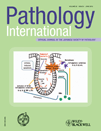
PATHOLOGY INTERNATIONAL
Uncovering Breakthroughs in Medical Science Since 1951PATHOLOGY INTERNATIONAL, published by WILEY, stands as a distinguished journal in the field of pathology and forensic medicine, serving as an essential resource for researchers, clinicians, and students alike. With its ISSN 1320-5463 and E-ISSN 1440-1827, PATHOLOGY INTERNATIONAL has established itself since its inception in 1951, navigating through an evolving landscape in medical science with insights and breakthroughs up to 2024. It holds a commendable Q2 ranking in both the Medicine (miscellaneous) and Pathology and Forensic Medicine categories, indicating its robust influence and quality within these fields, as evidenced by its placement in the 70th percentile of Scopus rankings. While currently not an open-access journal, it provides access options that ensure valuable research remains available to the academic community. PATHOLOGY INTERNATIONAL commits to advancing the discipline through pioneering research articles, comprehensive reviews, and expert opinions that push the boundaries of understanding in pathology, thereby supporting the enhancement of diagnostic and therapeutic practices.
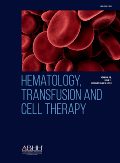
Hematology Transfusion and Cell Therapy
Elevating standards in cell therapy and transfusion science.Hematology Transfusion and Cell Therapy, published by Elsevier, is a leading Open Access journal dedicated to advancing the fields of hematology, immunology, and transfusion medicine. Since its establishment in 2018, this journal has provided a vital platform for sharing innovative research and clinical advancements in the management of blood disorders and cellular therapies. Based in Brazil, it attracts a global audience, facilitating access to high-quality research that influences clinical practice and policy. With a current impact factor that places it in the Q3 category for both hematology and immunology as of 2023, the journal is recognized for its rigorous peer-review process and commitment to disseminating significant findings. By featuring a diverse range of articles, from original research to reviews, Hematology Transfusion and Cell Therapy aims to foster collaboration and knowledge sharing among researchers, professionals, and students alike, empowering them to tackle emerging challenges in their fields.
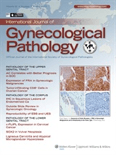
INTERNATIONAL JOURNAL OF GYNECOLOGICAL PATHOLOGY
Transforming insights into gynecological care.INTERNATIONAL JOURNAL OF GYNECOLOGICAL PATHOLOGY, published by Lippincott Williams & Wilkins, is a premier academic journal dedicated to the intricate field of gynecological pathology, serving a critical role in advancing the understanding of diseases related to women's reproductive health. Since its inception in 1982, this journal has established itself as a key resource for researchers, clinicians, and students, with a current impact factor that reflects its esteemed reputation; it is ranked in the Q2 category for both Obstetrics and Gynecology, as well as Pathology and Forensic Medicine, signifying its prominence in academic circles. The journal's scope encompasses a wide array of topics, including histopathological findings, diagnostic methodologies, and evolving therapeutic strategies, all pivotal to enhancing patient care. With a steadfast commitment to disseminating high-quality research until the projected year of 2024, the INTERNATIONAL JOURNAL OF GYNECOLOGICAL PATHOLOGY is an essential read for those looking to stay abreast of the latest developments in this vital area of medical science.

International Journal of Clinical and Experimental Pathology
Advancing Knowledge in Pathology and BeyondInternational Journal of Clinical and Experimental Pathology, published by E-CENTURY PUBLISHING CORP, serves as a vital resource for professionals in the field of pathology. With its ISSN 1936-2625, the journal has positioned itself within the competitive landscape of medical journals, achieving commendable rankings in Scopus, particularly in the categories of Pathology and Forensic Medicine (Rank #98/185) and Histology (Rank #38/58). Although its coverage in Scopus has been discontinued, the journal’s past contributions from 2009 to 2017 continue to be a touchstone for researchers interested in advancing their understanding of clinical and experimental pathology. The open-access format ensures accessibility to a wide audience, fostering collaboration and education in this essential medical discipline. By bridging clinical research and experimental findings, this journal plays a crucial role in disseminating knowledge and enhancing practices within pathology, making it an indispensable tool for researchers, professionals, and students alike.
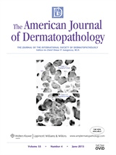
AMERICAN JOURNAL OF DERMATOPATHOLOGY
Exploring Innovations in DermatopathologyAMERICAN JOURNAL OF DERMATOPATHOLOGY, published by Lippincott Williams & Wilkins, is an essential resource for professionals and researchers engaged in the fields of dermatology, pathology, and forensic medicine. Established in 1979, the journal aims to disseminate cutting-edge research and advancements pertaining to the microscopic examination of skin disorders. With an esteemed impact factor that positions it well within the Q3 category of dermatology and pathology as of 2023, the journal ranks #81 out of 142 in dermatology and #130 out of 208 in pathology according to Scopus. Although it does not currently offer open access options, the journal provides valuable insights and substantial contributions to the understanding of dermatopathology, making it a vital tool for academics, clinicians, and students seeking to stay abreast of the latest findings and practices in the field. Its commitment to high-quality research continues to foster a deeper understanding of skin diseases, enhancing patient care and scientific inquiry alike.

Journal of Hematology & Oncology
Advancing the Frontiers of Hematology and OncologyJournal of Hematology & Oncology, published by BMC, is a leading open-access journal dedicated to the dynamic fields of hematology and oncology, with a continuous publication record since 2008. Based in the United Kingdom, this prestigious journal provides a platform for groundbreaking research, encompassing topics that span cancer research, hematological disorders, and molecular biology. With a remarkable Q1 ranking in multiple categories including Cancer Research, Hematology, Molecular Biology, and Oncology for 2023, it stands as a significant contributor to the scientific community. The journal's rigorous peer-review process ensures the dissemination of high-quality studies that drive advancements in these critical areas of medicine, boasting an impressive Scopus rank in the top echelons of its fields. As an open-access publication, it promotes widespread accessibility and sharing of knowledge, making it an indispensable resource for researchers, clinicians, and students striving to make advancements in understanding and treating hematological and oncological diseases.

Journal of Hematopathology
Connecting clinicians and researchers for better diagnostics.The Journal of Hematopathology, published by SPRINGER HEIDELBERG, serves as a vital resource in the fields of hematology, histology, and pathology. Established in 2008, this peer-reviewed journal aims to foster the exchange of knowledge among researchers, clinicians, and students by publishing original articles, reviews, and case studies that contribute to the understanding of hematopathological disorders. While the journal currently ranks in the fourth quartile in various categories including hematology and histology, it positions itself as a platform for emergent research and insights, addressing the evolving landscape of blood-related diseases. Although not an open access journal, it provides crucial access to research findings for professionals looking to stay abreast of developments in pathologic diagnostics and therapeutic strategies. As it continues to grow, the journal remains committed to enhancing the knowledge base and scientific discourse in hematopathology.
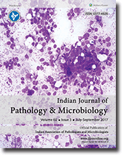
Indian Journal of Pathology and Microbiology
Connecting Researchers to Transform Medical ScienceIndian Journal of Pathology and Microbiology, published by Wolters Kluwer Medknow Publications, is a distinguished open-access journal that has been fostering knowledge dissemination in the fields of pathology and microbiology since 2008. With an ISSN of 0377-4929 and E-ISSN 0974-5130, this journal serves as a critical resource for researchers and practitioners committed to advancing their understanding of medical sciences in India and beyond. Spanning decades of valuable research contributions since its establishment in 1972, it provides a platform for peer-reviewed articles that explore current trends and innovations in medicinal pathology and microbiological studies. Although it holds a Q4 ranking in categories such as medicine and microbiology, it maintains a notable Q3 classification in pathology and forensic medicine, highlighting its relevance to contemporary scientific discussions. Accessible freely to a global audience, the journal plays a pivotal role in enhancing scholarly communication and collaboration, making it an indispensable tool for students, professionals, and researchers alike aiming to contribute to this evolving discipline.

Hematologie
Empowering the Future of Hematological SciencesHematologie is a highly regarded journal in the field of hematology, published by JOHN LIBBEY EUROTEXT LTD. With an ISSN of 1264-7527 and an E-ISSN of 1950-6368, this journal has established itself as a vital resource for researchers, clinicians, and students dedicated to advancing the understanding of blood disorders and treatments. Although the journal's coverage in Scopus was discontinued in 2018, it has continually provided invaluable insights and research findings. The journal aims to foster knowledge sharing and discussion in hematology, exploring innovative methodologies and emerging trends in the field. With a commitment to quality research, Hematologie remains an essential platform for disseminating critical findings that can drive clinical practice and influence future studies in hematological sciences.
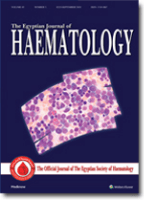
Egyptian Journal of Haematology
Elevating Expertise in Blood Disorders and Transfusion MedicineThe Egyptian Journal of Haematology, published by WOLTERS KLUWER MEDKNOW PUBLICATIONS, stands as a pivotal resource in the field of hematology, particularly within the context of Egypt and the broader Middle Eastern region. This journal is dedicated to disseminating high-quality research that explores the latest advancements in blood disorders, hematologic malignancies, and transfusion medicine. With a focus on original research, case studies, and reviews, it aims to provide a comprehensive platform for hematologists, researchers, and healthcare professionals to enhance their understanding and management of hematological conditions. Although it is not an open-access journal, the rigorous peer-review process ensures that only the most impactful studies are published, contributing to the journal's reputation in the academic community. The Egyptian Journal of Haematology serves as an essential tool for advancing knowledge, improving clinical outcomes, and fostering collaboration among experts in the field.